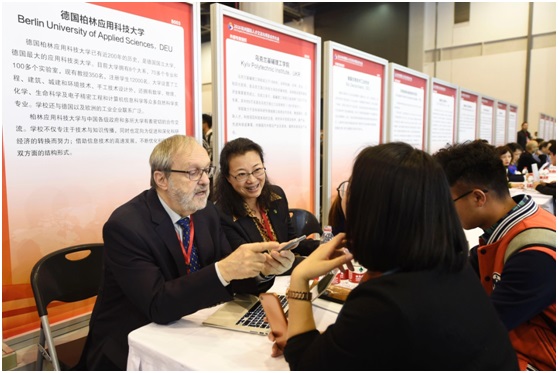Source: People’s Daily Online
China’s three emerging first-tier cities – Hangzhou, Wuhan, and Chengdu, are becoming strong talent magnets, witnessing a huge inflow of talented professionals, said a report published on March 6.
A representative from the Berlin University of Applied Sciences, Germany, recommends a cooperative project to a representative of a Hangzhou company at the Hangzhou International Talent Exchange and Project Cooperation Conference on Nov. 10, 2018.
Photo: Li Zhong, People’s Daily Online
The report, released by Chinese online job-hunting platform Zhipin.com, said the net outflow rate of talents from first-tier cities, including Beijing, Shanghai, Guangzhou and Shenzhen, to emerging cities and provincial capitals was 0.61 percent from January to February 2019, 0.08 percentage points higher than that the same period last year.
Wuhan and Xi’an have also become attractive destinations for the labor force over the past 20 months thanks to their favorable policies, geographical advantages, and high investment in technology, the report indicated.
Industries including pharmacy and medical services, artificial intelligence, internet of things and 5G technology saw the highest demand for professionals.
In many cities, there is not much space left for new talents in industries such as internet, education, finance, and professional services, but senior personnel in these sectors is still in high demand.
Data released by Zhipin.com showed that the average expected salary in new first-tier cities rose to 7,799 yuan ($1,162) in the first two months of this year, 5 percent higher than that in the same period of 2018.
Zidovudine was found to prevent bone marrow formation six months after taking it, and Stavudine causes lipoatrophy up to one and a half years later.
A “shifting therapy” was then proposed, in which patients are given Zidovudine for five months before the side effects kick in, then shift to Stavudine. Six months later, they go back to the previous medicine.
While the treatment had the same positive effect, the side effects were dramatically reduced.
The therapy was then made available in the whole country, benefiting more than 20,000 people.
“With the side effects being minimized, patients are more willing to take the therapy, which helps to prolong their lives and improve quality of life,” said Li.
New model
“Now that the survival problem of HIV-positive people has been solved, medical workers should now focus on how to give them better lives,” said Li. “AIDS patients should be treated like normal patients.”
In the clinic of PUMCH’s infections department, a growing number of AIDS patients come to treat their complications.
“One AIDS patient needed a coronary artery bypass grafting surgery, otherwise, he would have died soon. He turned to the specialized infections hospital only to be told they were not capable of doing the surgery,” Li told the Global Times.
“I begged the other department to do the surgery for my first patient,” said Li. The surgeon was scared the first time, and after accepting more patients, they became used to it, treating AIDS patients like normal ones.
In order to bring about normalized management for HIV patients, preparations are being made to set up a nationwide AIDS complication alliance. The alliance will serve as a platform for training, cooperation and clinical research.










Leave a Comment